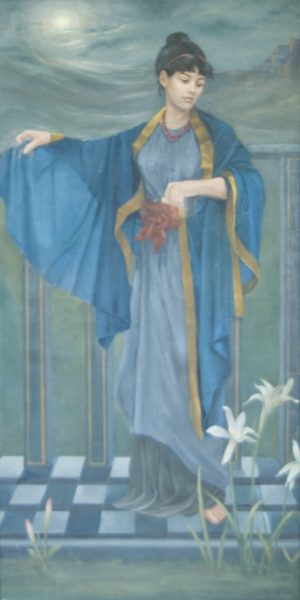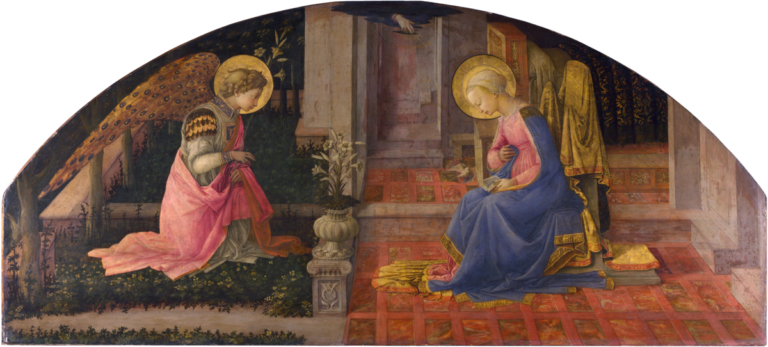So, for those of you still with me, I am asking myself whether strict realism is the way I want to go or whether some aspect of it may have to be abandoned in order to touch deeper mythic truths. I honestly don’t know. Let us look at a concrete example of a picture I started a couple of years ago and have been fiddling with off and on as I, perhaps unconciously, tried to resolve the conundrum of how much realism I want in it. This picture is called Luna and represents moonlight, and I have tried to evoke many of the associations which naturally spring to mind at the sound of that word.
Now, as the picture stands (unfinished of course) I think I have captured, to take one example, the effect of light passing through the drapery over the figure’s arm but here’s the rub; when I look at the mythic painting (to adopt Ruskin’s term) of Burne-Jones and the early Italians who inspired him, Botticelli Fillipo Lipppi etc I see absolutely no attempt to capture such light effects, absolutely no cast shadows for example and only enough form shadow to give a minimal suggestion of solidity. Now that wasn’t done through carelessness or ignorance, these artists must have felt that the faithful recording of such natural phenomena was of no aid in their expressive intent and quite possibly directly antithetical to it.
With this type of painting which I think may be called (without any pejorative inference) decorative painting everything is subservient to the beauty of colour. So I wonder if I need to sacrifice this clever little bit of rendering in my picture in order to emphasie the beauty of solid masses of colour and thus perhaps make my painting less of this world and consequently more…. more what? It is difficult to find the words especially as I am far from wishing to impute any lack of poetry or mythic quality amongst the best of our realist painters. . However if I want to paint pictures which move people in the way I am moved by the images I have shared in these posts I feel I must try, especially as I am in the fortunate position of not relying on painting for my income it seems ridiculous not to paint whatever I feel compelled to paint.
My plan now is to make a smaller version of my picture “Luna”, (the current one is 100cm x 50cm so large for me) and we will see where it takes me. Maybe it will end up a prosy failure and fall between two stools, neither mythic nor good realism but maybe, just possibly it will be a pointer to future development. There is only one way to find out.
For anyone who has read to the end of this self indulgent meandering, many thanks and if you have any thoughts at all on the subject I would be enormously grateful if you shared them with me.




Is it possible that the painting you posted in part I: Edward Burne-Jones: “Music” is a study for bigger or larger work which he maybe never actually started? Maybe it’s a daily painting kind of work or just a painting with few layers and did not continue for one reason or other! Anyway, these 3 parts were interesting to read. Your right, realistic painting is difficult and time consuming. They say no matter how good you are, it really doesn’t get easier. Maybe it’s because we constantly search for improvement. One approach to this matter is to continue trying to paint realistic, turning the form, good values etc. Sometimes painting turns out something else and not necessarily bad, in which case in my opinion it’s important to stop painting at correct point and leave the painting as it is. I have lots of those too and I keep them b/c I think they are good paintings, although I never publish them. I think just continueing working and painting the painter’s style keeps forming.
Thanks for your thoughts Sirkka. The painting isn’t a study, its a finished work. Later in his career he produced large finely wrought pictures but at the same time he continued with smaller less finished paintings where the expressive quality is paramount. I’m sure you are right that “style” must naturally evolve through continued work rather than be something to be aimed at, although at the same time I think its important when starting a work to have a good idea of how you want it to look when finished don’t you?